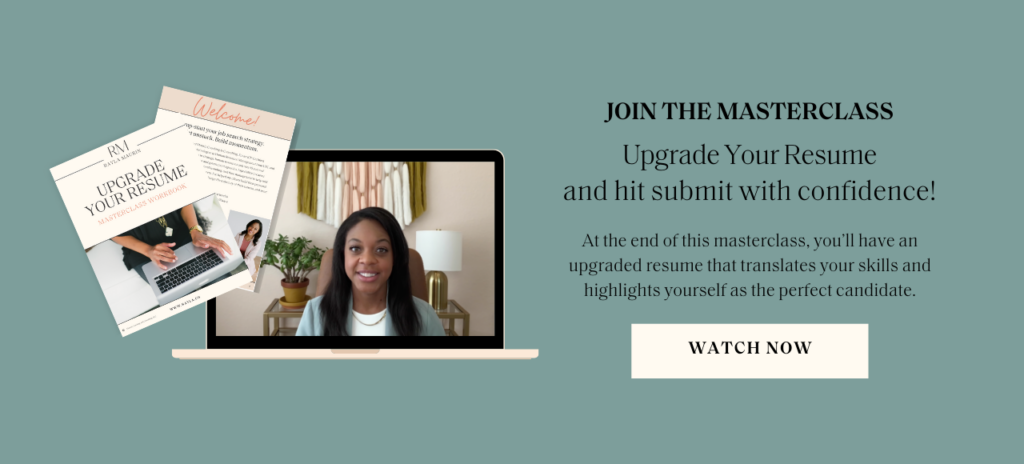Why does writing a resume feel like writing your final English paper for your undergraduate degree?
If your paper sucks, you don’t pass the class.
If your resume sucks, you don’t get the job.
The stakes are high. It’s no wonder you feel overwhelmed by the process.
When you look at the different resume templates on Creative Market*, it seems like there are a million different things to include in a resume.
Certain Skills?
Volunteer Experiences?
And are you supposed to add a picture or not?! (By the way, the answer is absolutely not, under no circumstances. Seriously!)
These resume templates might look good, but they’re so basic that it’s no wonder you’re not getting interviews — your resume looks just like everyone else’s.
I’ve been in the HR and career coaching field for 8 years, so I have first-hand knowledge of what you should (and shouldn’t) include on your resume.
If you don’t want to settle for a job and are ready to accept that higher-paying position, here’s what you need to put on your resume.
RELATED: The Most Common Resume Summary Clichés (VIDEO)
7 Things To Include in a Resume (For Bots and Recruiters)
Choosing what to include on your resume can feel like trying to pick the perfect dish from a menu where everything looks good.
I’ve been where you are, so here’s the general resume outline I created to make tailoring my resumes go by much quicker:
The standard format for a resume includes a:
- Header
- Summary or Objective
- Education
- Experience
- Skills
- Contact Information
But you knew that already.
What you don’t know is how to write the details of your job skills and experience so that your resume bypasses the ATS software, makes it into the hands of a real-life human recruiter, and gets you that initial interview.
I’m breaking it down, piece by piece, so you know exactly which things to include on your resume.
RELATED: How to Get a Job Fast
1. Contact Information
- Full Name: First and Last
- Phone Number: Include the area code if it’s remote.
- City, State: Even if it’s a remote position. (Not your full address – they don’t know you like that!)
- Professional Email Address: Keyword… professional. Gmail is free. Replace your dumbthicc@hotmail.com with something more polished/distinguished/straightforward – any variation of your name is perfect.
- LinkedIn Profile URL: As an HR professional, I can tell you we always want to see this.
- Portfolio or Website: If applicable.
Easy enough, right? Now let’s move on to the stuff that actually helps you get the job instead of someone else.
2. Professional Summary/Objective
The summary should be a few short sentences and include the job title you’re applying for and how many years of experience you have.
The real purpose of this section is to intrigue the reader to keep reading.
Remember: real people read your resume. You have about 7 seconds to impress the recruiter and convince them you’re the candidate who will make their job easier.
That’s the candidate who moves forward in the interview process.
Uniqueness is key here. Your Unique Value Proposition (UVP) needs to stand out. Every applicant these days is an “energetic, problem-solving, organized, team-playing, communicative, collaborative, driven, passionate, innovator”– you get the picture.
The best way to find your UVP for the role is to leave out the fluff and succinctly answer these 3 questions:
What problem do you solve?
Be specific by adding adjectives.
- Overbooked startups?
- Overwhelmed CEOs?
- Tech-adverse customers?
- Exhausted job seekers?
What are the skills/tools that you use to solve that problem?
Use an action verb + noun.
- Build CRM systems
- Navigate difficult conversations
- Create resources
- Manage projects
- Lead design teams
- Develop content workflows
What is the result/impact of your solving that problem?
- To simplify processes and streamline workflows
- To reduce mistakes and mitigate risk
- To seamlessly onboard new hires and increase employee retention
Now use this prompt to create your summary UVP:
I [action verb] [noun] that help [who you help] to/get/be/make [your why].
Examples of powerful UVP resume summaries:
- I [build] [CRM systems] that help [overbooked startups] make [booking clients easier].
- I [navigate] [difficult conversations] to help [tech-adverse customers] [solve their tech problems].
- I [create] [resources] that help [exhausted] [job seekers] get [hired].
3. Skills To Put on a Resume
Knowing which skills to put on a resume and which to leave out is key to keeping a recruiter’s attention.
Most people list their soft skills.
People who get hired list their hard skills.
- Soft skills: Leadership, creativity, communication
- Hard skills: Data analysis, project management, proficiency in software tools like Microsoft Excel, Adobe Photoshop, SEO, and HTML/CSS coding.
When I was helping my client Ed (who worked as a Non-profit Executive) tailor his resume for a career change, the first thing we did was list his strengths. In his case, it was Microsoft Excel, customer service, and project management as the Grant Writing Officer for the organization.
But Ed didn’t want to work with numbers anymore — he wanted to work with people.
To niche down his diverse skill set and tailor it to the job he wanted, Ed researched the job he wanted to see which skills were universally expected for these positions.
From there, it was just a matter of narrowing down his transferable skills (customer service and project management) and relating them to his previous work experience.
Which brings us to…
4. Work Experience
This is the meat and potatoes of your resume.
And it’s the one almost everyone screws up.
Inexperienced resume writers will tell you to copy and paste the job description and finesse it with your own words.
Human Resource professionals like me, who have read more resumes than bad Bumble profiles, will tell you this makes our eyes glaze over.
Then, your resume will be in the (digital) trash.
This is why I’m such a huge proponent of storytelling in your resume. Don’t just tell me you “Increase customer satisfaction by 300%.”
Articulate what problem you solve, how you solve that problem, and the impact or result of having solved that problem at the workplace.
Example:
- Articulate what problem you solve: Our customer satisfaction rate dropped by 19% in Q1.
- How you solved that problem: Integrating a reward-based feedback system led our customer service team to…
- Impact or result of you solving that problem: Increase customer satisfaction by 300% in Q3.

5. Education
Has it been over 10 years since you’ve stepped foot into a classroom?
Doesn’t matter. We want to see it.
Here’s the standard, acceptable format:
Degree – School Name – Graduation Year (or expected date).
Sharing the date is optional!
6. Certifications, Tools, and Tech
Showing your degrees and furthering your education is what recruiters and hiring managers want to see.
They want to hire people who go above and beyond what is expected of them.
Have you taken any continuing education courses? List them in this section, along with tools or software you’ve used (even if they were for personal projects):
- HubSpot Content Marketing
- Google Analytics
- SEO Fundamentals by Moz
- Canva
- Google Docs
- WordPress
- Adobe Photoshop
RELATED: How To Address Being Laid Off on Your Resume (EXAMPLES)
9 Things You Should NOT Include on a Resume
- Unprofessional Contact Information: Avoid quirky or outdated email addresses like coolguy123@gmail.com. Use a professional email (e.g., firstname.lastname@gmail.com).
- Personal Social Media Accounts: Unless they’re relevant (e.g., LinkedIn or a relevant portfolio).
- Personal Information: Never include your age, gender, marital status, religion, political affiliation, or a picture. I won’t debate you on the last one.
- Irrelevant Work Experience: Don’t include unrelated jobs unless you can highlight transferable skills.
Example: A summer job at a fast-food restaurant might not belong on a tech or writing-focused resume.
- Long Paragraphs or Too Much Text: Avoid dense blocks of text. Use concise bullet points with action verbs.
- Outdated Skills or Experiences: Skip listing old or obsolete technologies (e.g., “Proficient in MS-DOS”). Focus on current, relevant skills. This goes for your education, too.
- Excessive Jargon or Buzzwords: Avoid clichés like “team-player” or soft skills like “results-oriented” unless you back them up with specific examples. Show vs. Tell.
- Salary Expectations or References: Salary discussions are for interviews or negotiations, not your resume. You don’t need to write “References available upon request” — it’s usually assumed.
- Typos or Formatting Issues: Proofread thoroughly!* Typos, inconsistent formatting, or poor grammar can ruin a great first impression.
FREEBIE: 10 Questions to Ask in a Job Interview
What Looks Good on a Resume?
An effective resume is in the details.
Too many applicants get hung up on detailing their job responsibilities.
The companies interviewing you care about results and whether you can do the job.
They want to know that you will make a measurable contribution when they hire you.
Don’t just tell them about job duties, explain how your contributions made an impact at your prior organizations, and paint the picture of how you will do the same when they hire you.
A few other fun things to include in a resume:
Personal Projects or Side Hustles with Transferable Skills
- Example: Created and managed a travel blog, growing readership to 10,000 monthly visitors through SEO and social media marketing.
Relevant Volunteer Experience
- Example: Organized a local fundraiser, raising $15,000 for a community initiative.
Certifications Beyond Your Field
Unique certifications (e.g., Sommelier, Personal Trainer, or Foreign Language Proficiency) can add depth and make you memorable.
- Example: Fluent in French, used during international business trips.
Online Presence or Portfolio
- Example: Creator of a TikTok account on marketing tips with 25K followers and 1M+ views.
For a step-by-step guide to creating your most effective resume, join my on-demand masterclass, Upgrade Your Resume!
*This is an affiliate link.

+ show Comments
- Hide Comments
add a comment